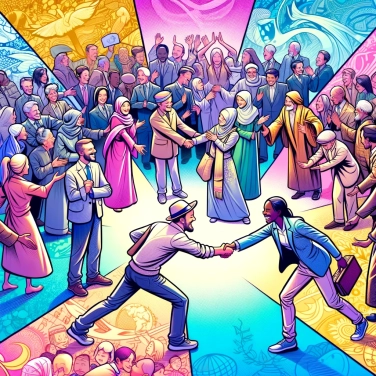Greeting customs vary from country to country due to cultural, historical, and social differences specific to each society. These variations can be influenced by factors such as religion, ancestral traditions, or dominant values in each region.

The way we say hello often reveals the cultural identity of a country. Each culture carries values such as respect, hierarchy, or intimacy, which are reflected in its greetings. For example, in Japan, the bow is deeply rooted in the notion of respect and discretion. In France, the kiss on the cheek expresses closeness, social connection, and friendliness. Among the Maori people in New Zealand, the nose contact known as hongi clearly signifies a spiritual and symbolic exchange. Even simple gestures like a handshake vary greatly depending on the country: firm and energetic in the United States, gentle and brief in China. These differences simply arise from the fact that each country builds its identity and codes according to its own beliefs, values, and the way it expresses relationships between individuals.
The greetings used in many countries often stem from specific historical events or customs. For example, in medieval Europe, offering a handshake indicated that one was not carrying a concealed weapon, directly establishing mutual trust. This practice has continued to this day, becoming a common greeting in many Western countries. On the Asian side, in Japan, the greeting by bowing dates back to the samurai era, as a sign of respect and humility towards others, subtly revealing one’s neck, a vulnerable area. In some African regions, colonial history has merged traditional greetings with Euro-Western forms, creating unique hybrid greetings. History thus clearly leaves a strong imprint on how people meet and greet each other.
In cold countries, greetings often avoid prolonged physical contact. Warmly shaking hands or hugging when it's -20°C is not ideal. Instead, a slight nod of the head or a quick gesture will suffice. In contrast, warm regions encourage physical contact, which is often warm and tactile, with frequent embraces. In Africa or Latin America, affection and hospitality are often expressed through a prolonged handshake, hugs, or even kisses. The environment also influences behavior: in desert areas, people often keep a bit of distance as a sign of respect for personal space, a matter of survival and intimacy; whereas in dense urban areas, where personal space is limited on a daily basis, close social interactions become the norm.
Greetings often reflect the dominant social values of a country. A simple example: in societies where equality is very important, such as Scandinavian countries, formal greetings are rare; people go straight to using first names and informal address. In contrast, in highly hierarchical countries—like Japan or South Korea—greeting protocols are strictly observed based on social hierarchy. The political context also plays a role: when political regimes are authoritarian or emphasize a strong identity, gestures of greeting can become very codified, almost ceremonial, serving to subtly remind who is in charge. It is worth noting that during periods of political or social tension, certain ways of greeting may be encouraged or, conversely, discouraged, as they become symbolic of belonging or dissent.
Today, thanks to the media and globalization, certain greetings have clearly become international. The handshake, for example, often associated with the business world or official meetings, has spread everywhere, even in places where it was not at all customary before. Movies, series, and social networks continually broadcast gestures like the check or the simple "hi" wave, which are gradually becoming universal, especially among younger generations influenced by popular culture. However, even though many places adopt gestures because they are "cool" on screen, many still strongly resist these changes. They are keen to maintain their traditions because greetings remain an important way to assert and preserve one's cultural identity.
In Japan, it is common to greet with a bow called 'ojigi'. The depth and duration of this bow indicate the level of respect towards the person being greeted.
Among the Māori of New Zealand, the traditional greeting called 'hongi' involves pressing noses and foreheads together to symbolically share the 'breath of life.'
In India, the greeting 'namaste' is literally translated as 'I bow to you' and reflects a belief that a spark of divinity resides within each of us.
Did you know that in Nordic countries like Finland, prolonged eye contact during greetings is considered respectful and sincere, whereas elsewhere it might be seen as awkward or intimidating?
Although no greeting is truly universal, smiling warmly while slightly bowing your head is generally considered a cautious and respectful way to greet, positively perceived in many cultures and unlikely to offend.
Hierarchical cultures often explicitly value signs of respect related to age, social, or professional roles, which is reflected in specific greetings depending on the individuals involved. These practices serve to reaffirm respect and openly acknowledge this status. In more egalitarian societies, however, the distinctions in greetings based on status or age are less pronounced.
Sure! Here’s the translation: "No, usually local populations show tolerance towards visitors who are not exactly familiar with their customs. However, it is often appreciated to inquire in advance about local practices in order to demonstrate respect for the host culture and avoid awkward situations."
The pandemic has led to significant changes in greeting practices, drastically reducing physical contact (handshakes, kisses). In many countries, contactless alternatives have been widely adopted, such as elbow greetings, verbal greetings, or other gestures that respect social distancing.
The differences largely stem from the degree of social closeness valued in each culture, influenced by religious beliefs, collective or individual values, and local social norms. Cultures where social closeness is high often practice physical greetings (hugs, warm handshakes), while those that prioritize personal space adopt contactless greetings (verbal greetings, hand waves, or bows).

0% of respondents passed this quiz completely!
Question 1/7